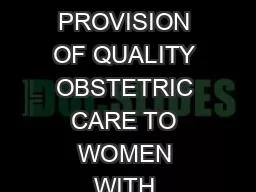

Gloria Adoyi Salisu Mohammed Ishaku Oginni Ayodeji Babatunde Karen Kirk 20 th World Congress meeting of the International Society for the Study of Hypertension in Pregnancy ISSHP 24 October 2016 ID: 807186
Download The PPT/PDF document "PERSISTING CHALLENGES IN THE PROVISION O..." is the property of its rightful owner. Permission is granted to download and print the materials on this web site for personal, non-commercial use only, and to display it on your personal computer provided you do not modify the materials and that you retain all copyright notices contained in the materials. By downloading content from our website, you accept the terms of this agreement.
Slide1
PERSISTING CHALLENGES IN THE PROVISION OF QUALITY OBSTETRIC CARE TO WOMEN WITH PRE-ECLAMPSIA AND ECLAMPSIA IN NIGERIA: ASSESSMENT OF HEALTH PROVIDERS' PREPAREDNESS AND FACILITY READINESS
Gloria Adoyi Salisu Mohammed Ishaku; Oginni Ayodeji Babatunde; Karen Kirk.
20th World Congress meeting of the International Society for the Study of Hypertension in Pregnancy (ISSHP) 24 October 2016Sao Paulo, Brazil.
Slide2Background
In Nigeria, an estimated 40 percent of pregnant women experienced pregnancy-related health problems during or after pregnancy and childbirth (
Mutihir, 2011).Common maternal health problems/complications a woman may experience during pregnancy include Pre-eclampsia and Eclampsia (PE/E).Screening, early antenatal detection, and timely management are the most effective
ways for preventing
morbidity
and mortality from these pregnancy-related
disorders
However
,
low
level of access to, and utilization of quality obstetric care is a major
contributing factor to
why most
maternal deaths occur
in
Nigeria.
Slide3Objectives
To assess the preparedness of frontline health care providers and facilities readiness for early detection and management of PE/E in seven states in
NigeriaTo analyze the gaps in providers’ competence to prevent, detect and manage PE/ETo determine facility capacity to manage PE/E
Slide4FACILITY INSIGHTS
EARLY DETECTION OF PE
Slide5Study area
Slide6Data collection : June
to August, 2015Study sites: Secondary, primary health care facilities
and a few tertiary Study Design: Quantitative research using a self- administered, semi-structured questionnaires. Provider AssessmentFacility Inventory
methodology
Slide7Summary of quantitative data
States
Health providerInterview Facility inventory Cross River5911Ebonyi
4620
Ondo
59
11
Kogi
44
8
Sokoto
61
11
Bauchi
55
14
Katsina
55
21
Total
379
96
Slide8HEALTH PROVIDERS' PREPAREDNESS findings
Slide9Type of facility (inventory)
Slide10Distribution of health provider respondents by: (n=376)
Level of health facility
Type of provider
Slide11PROVIDER KNOWLEDGE: A
pregnant woman was seen in the ANC at 12 weeks gestation with BP of 160/100 mmHg with no proteinuria. What is the diagnosis?
Slide12PROVIDER KNOWLEDGE:
What are the signs/symptoms of PE, SPE & E?
Slide13PROVIDER KNOWLEDGE: What drugs do you use to control hypertension in
clients with PE with mild to moderate hypertension?
Slide14PROVIDER PRACTICE: Assessing the risk of PE, screening for PE and advising client of danger signs of PE/E
Slide15PROVIDER KNOWLEDGE: Less than 21% were aware of prophylactic drugs for prevention of PE
Slide16PROVIDER KNOWLEDGE
Only 12% providers knew correct loading dose of MgSO4 (Pritchard regime) 10% knew the correct maintenance dose7% knew which drug used to manage MgSO4 toxicity<11% providers could list 3 ways
to monitor MgSO4 toxicity
Slide17FACILITY READINESS
Slide18FACILITY INVENTORY: How do facilities obtain MgSO4?
Slide19Availability of guidelines for
management of PE/E , ANC equipment and MgSO4
You see, the problem here is that, all these policies are available at the national level; but we the implementers don’t have or see the copies.
Slide20INVENTORY: Is MgSO4 used for treating Pre-eclampsia or eclampsia in this facility? (n-96)
Slide21Conclusion
Reduction in PE/E-related mortality and morbidity hinges on health care providers’ ability to recognize PE/E and have essential tools and commodities available to manage cases
Attention must be paid to the in-service training of frontline antenatal care providers (in Nigeria, these include nurses, midwives and community health extension workers) to be able to early detect, prevent and manage PE/E effectively. H
ealth care facilities should be equipped with essential
tools and live-saving commodities for managing women with PE/E.
Slide22